Holi- the festival of colors
When good reigns triumphant over evil,
And the cold winters die down,
The cheerful and rejuvenating air of spring is finally upon us.
The sky is painted in pastel shades of pink, green and blue,
And the mellifluous rhythm of the dholak and traditional ballads can be heard by all.
While malicious spirits are set ablaze in a bonfire,
People gather to eat scrumptious meals.
Saccharine deep fried dumplings stuffed with curd and dried fruits;1
Fragrant diamonds decorated with nuts2, doughy pancakes with a cardamom cream;3
Crispy circular wafers, served with chickpeas and potatoes;4
Oblong savory treats, enjoyed with spicy pickles;5
Peppery noodles in an onion and tomato gravy, flavored with an Indian spice mix:
Red chilies, coriander seeds, cinnamon sticks, cloves, cumin and black cardamom;6
Drinks made with milk, yoghurt and seasonings, at times laced with
cannabis leaves and flowers.7
The flames have burnt out and turned into ash,
And the once deafening music has died down to a faint hymn.
The colors have settled into heaps on the pavement,
Plates formerly brimming with food have been polished.
With well-fed belly’s and a full heart,
The festivities come to a sweet end.
What piece did you choose to imitate?
I chose to imitate two pieces ‘Dong Huang Taiyi (Grand Unity, Spirit of the Eastern Sky)’ and ‘The Summons of the Soul’ both from Chu Ci, by Qu Yuan.
Why did you choose this piece?
I felt nostalgic while reading Grand Unity as it talks about an ‘auspicious day’ with ‘singing’, food offerings and ‘priestesses’. This scene is reminiscent of many festivals celebrated in India which are renowned for their feasts, devotional activities and celebrations. I used the verse as inspiration to set the scene for the spring harvest carnival my poem is based on. I further enjoyed the detailed descriptions of the dishes in ‘The Summons of the souls’. I based the outlines of the foods eaten during the festival of Holi, on the style of this prose.
What did you learn about the culture of the original author through imitating his or her style?
The poem ‘Dong Huang Taiyi’ displays how Chinese food acts as a link to the spiritual world. ‘Take up the fragrant flower offerings, the meats cooked in melilotus, served on orchid mats, And libations of cinnamon wine and pepper sauces!’, ‘The five notes mingle in rich harmony, And the god is merry and takes his pleasure.’ Food offerings and songs are instruments used to please the holy spirits. The following lines from ‘The Summons of the Soul’ further bolster this idea ‘Oh Soul, come back! Why should you go far away? All your household has come to do you honor, all kinds of good foods are ready’. Food thus ventures beyond its conventional purpose of nutrition, and transcends into a symbol of reverence in Chinese culture.
What did you learn about your own culture while writing?
While writing and researching the food items eaten during Holi, I learnt that there are certain dishes which are associated with this Indian festival. I was curious to learn if other festivals celebrated here were accompanied by the same dishes or were characterized by a different assortment of foods. On further research I discovered that during Diwali deep fried vegetables and meats, samosas, potato patties, curdled milk dough balls and other dishes are served. On the auspicious day of Ram Navami rice puddings, spiced buttermilk, coconut dough balls, milk cakes and other food items are traditionally eaten. Sweet flatbread, coconut rice and sweet strained yoghurt with nuts are consumed during Ganesh Chaturthi. Many other festivals have distinct sweet and savory dishes linked to them. Therefore, in the Indian culture, certain food items have become synonymous with various festivals and auspicious occasions. Another thing I learnt is that Indian people love deep frying everything, even desserts!
Is there cultural DNA embedded in the piece you read and in your piece? How does this DNA manifest in the texts?
Methods of celebration – ‘Flourish the drumsticks, beat the drum!’, ‘The singing begins softly to a slow solemn measure’, ‘malicious spirits are set ablaze in a bonfire’, ‘…traditional ballads can be heard’, and food items eaten – ‘Stewed turtle and roast kid’, ‘Braised chicken, seethed tortoise…’, ‘Crispy circular wafers’, ‘Oblong savory treats’ are thoroughly documented in the pieces I read and in my poem. These actions and food items portray the culture and traditions deeply embedded into Chinese and Indian festivals.
 1. Gujiya
1. Gujiya
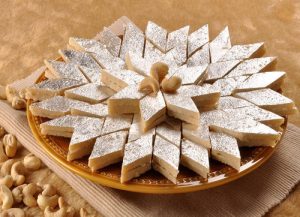 2. Barfi
2. Barfi
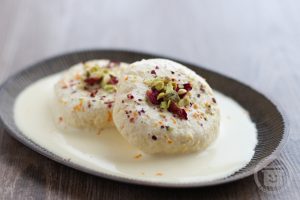 3. Ras Malai
3. Ras Malai
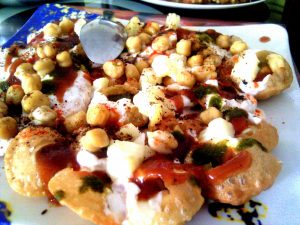 4. Papri Chaat
4. Papri Chaat
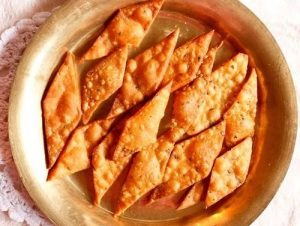 5. Namak Paare
5. Namak Paare
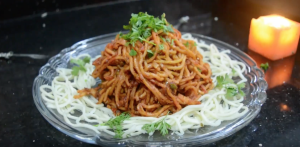 6. Pav-Bhaji Noodles
6. Pav-Bhaji Noodles
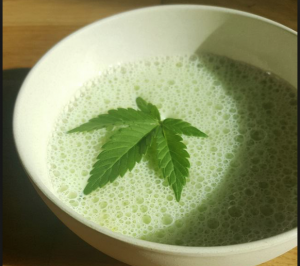 7.Bhaang/Thandai
7.Bhaang/Thandai
